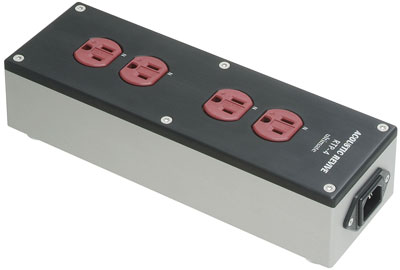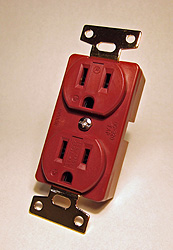Acoustic Revive: RTP-4 Power Conditioner
| Acoustic Revive: RTP-4 Power Conditioner |
| An Acoustic Revival Indeed |
|
|
|
November 2008 |

I suppose if I had been told there were sophisticated proprietary electronics inside the RTP-4 Ultimate, virtually lossless inductors made of pure silver foil, capacitors manufactured of rare earth minerals and super conductive alloys, resistors made of carbon so pure it was close to diamond, designed and manufactured along lines derived from radically original computer algorithms created by a reclusive genius who is also a classical musician, I might find the audible results more plausible. None of that applies, though. The male IEC connector (the RTP-4 requires a separate power cord) is wired directly to the AC receptacles. Electrically that’s it, completely passive. The RTP Ultimate series start with an ingot of 2017 alloy dualumin. What happens to that ingot in creating the final product is a paean to both a particular approach to power conditioning, and to an obsession with quality. It’s a mighty interesting story, but if you already know it, you may skip the next several paragraphs.

 How it’s made. The RTP-4 begins life as an 8.8 pound ingot of age-hardened duralumin, the sort of material they use to manufacture airplane fuselages. (The RTP-2 uses a 6.6 pound ingot, the RTP-6 a 13.2 pound ingot.) Duralumin is an alloy of aluminum (~95%), copper (~4%), magnesium and manganese (<1% each). Minimizing vibration transmission is one of the central goals of the RTP design, and duralumin has been tested and shown to rapidly dissipate mechanical energy. (Vibration absorption is the conversion of mechanical energy into heat energy.) Duralumin is also very hard: it takes eight hours of CNC machining to manufacture the RTP-4 chassis to a 25mm thickness. The machining process incorporates integral mounts for the AC receptacles; thus they are supported by the massive chassis rather than the cover plate. Acoustic Revive believe that a machined chassis is acoustically superior to one put together with rivets or welds. [Clement Perry’s recent visit to Japan and the various Acoustic Revive manufacturing facilities confirms these claims says he. His report is due any day and features plenty of great photos like above].
How it’s made. The RTP-4 begins life as an 8.8 pound ingot of age-hardened duralumin, the sort of material they use to manufacture airplane fuselages. (The RTP-2 uses a 6.6 pound ingot, the RTP-6 a 13.2 pound ingot.) Duralumin is an alloy of aluminum (~95%), copper (~4%), magnesium and manganese (<1% each). Minimizing vibration transmission is one of the central goals of the RTP design, and duralumin has been tested and shown to rapidly dissipate mechanical energy. (Vibration absorption is the conversion of mechanical energy into heat energy.) Duralumin is also very hard: it takes eight hours of CNC machining to manufacture the RTP-4 chassis to a 25mm thickness. The machining process incorporates integral mounts for the AC receptacles; thus they are supported by the massive chassis rather than the cover plate. Acoustic Revive believe that a machined chassis is acoustically superior to one put together with rivets or welds. [Clement Perry’s recent visit to Japan and the various Acoustic Revive manufacturing facilities confirms these claims says he. His report is due any day and features plenty of great photos like above].
Duralumin is even more prone to oxidizing than pure aluminum, so once machined, the box is sand blasted, then treated with white alumite, a very hard, high quality anodized layer. The cover piece receives a hairline process, a fine textured pattern, and is then coated with black alumite. The result is quite attractive. The bottom of the chassis is then partially filled with powdered green carborundum. Powdered high quality quartz and gemstone-quality lithic tourmaline are added to an epoxy resin which is then poured onto the layer of carborundum. The potting mix is allowed the cure for about a week before further manufacturing takes place.
Under test conditions using 50mm x 200mm x 10mm material, it was found that a laminate of 7mm of duralumin with 3mm of brass nearly doubled the rapidity of dissipation of vibration compared to 10mm of duralumin.  Appropriately, Acoustic Revive use four brass feet on the RTP series. These adjustable feet are machined to accept inserts and then plated silver. The proprietary material inserted in the feet was developed by Professor Masao Sumita of the Tokyo Institute of Technology, with grant support from the Japan Science and Technology Agency. Acoustic Revive describe it as an “epoch making material” with an “overwhelming vibration control characteristic.”
Appropriately, Acoustic Revive use four brass feet on the RTP series. These adjustable feet are machined to accept inserts and then plated silver. The proprietary material inserted in the feet was developed by Professor Masao Sumita of the Tokyo Institute of Technology, with grant support from the Japan Science and Technology Agency. Acoustic Revive describe it as an “epoch making material” with an “overwhelming vibration control characteristic.”
 The electrical outlets used for the RTP series are Oyaide R-1 receptacles. The bodies of these outlets are made of dark red, 30% glass filled polybutylene terephtalate (PBT), the same extremely hard (Rockwell 118), thermally stable material that Oyaide uses in its plugs. The R-1s are manufactured to Acoustic Revive’s specifications, beryllium copper internal parts plated with silver and rhodium. Metal parts only then receive a -196 C cryogenic treatment by a third party. (The same procedure is followed for the male IEC connector.) These modifications are said to improve conductivity and what Acoustic Revive call “phase characteristic.”
The electrical outlets used for the RTP series are Oyaide R-1 receptacles. The bodies of these outlets are made of dark red, 30% glass filled polybutylene terephtalate (PBT), the same extremely hard (Rockwell 118), thermally stable material that Oyaide uses in its plugs. The R-1s are manufactured to Acoustic Revive’s specifications, beryllium copper internal parts plated with silver and rhodium. Metal parts only then receive a -196 C cryogenic treatment by a third party. (The same procedure is followed for the male IEC connector.) These modifications are said to improve conductivity and what Acoustic Revive call “phase characteristic.”
On the face of it I didn’t know what to make of the phrase, phase characteristic. Perhaps this was references to the relative phases of current and voltage under reactive load? Not at all. As Joe Cohen of Lotus Group USA (importer/distributor of Acoustic Revive products) reminded me, many aspects of the RTP design are necessarily determined empirically: that is to say, by listening. Existing electronic devices are not able to detect the perceived effects of, for example, alternate plating materials or dielectrics. The ear is far more sensitive.“…the movement the ear drum makes while listening to a quiet conversation is less than the diameter of a hydrogen atom, which is sufficient to activate the bones of the inner ear” (Hugh Milne, The Heart of Listening: a visionary approach to Craniosacral work). “Phase” is commonly cited in audio specifications, but in this case it is not measured, it is heard. And it varies with different plating materials and cryogenic treatment. It is the stuff of subjectivity, an area of audiophilia I’ve always tread with caution and skepticism. But it seems to me every bit as valid as saying, “I can’t measure it, therefore it doesn’t exist.”
![]()
Don’t forget to bookmark us! (CTRL-SHFT-D)
Stereo Times Masthead
Publisher/Founder
Clement Perry
Editor
Dave Thomas
Senior Editors
Frank Alles, Mike Girardi, Russell Lichter, Terry London, Moreno Mitchell, Paul Szabady, Bill Wells, Mike Wright, and Stephen Yan,
Current Contributors
David Abramson, Tim Barrall, Dave Allison, Ron Cook, Lewis Dardick, John Hoffman, Dan Secula, Don Shaulis, Greg Simmons, Eric Teh, Greg Voth, Richard Willie, Ed Van Winkle, Rob Dockery, Richard Doron, and Daveed Turek
Site Management Clement Perry
Ad Designer: Martin Perry







Be the first to comment on: Acoustic Revive: RTP-4 Power Conditioner